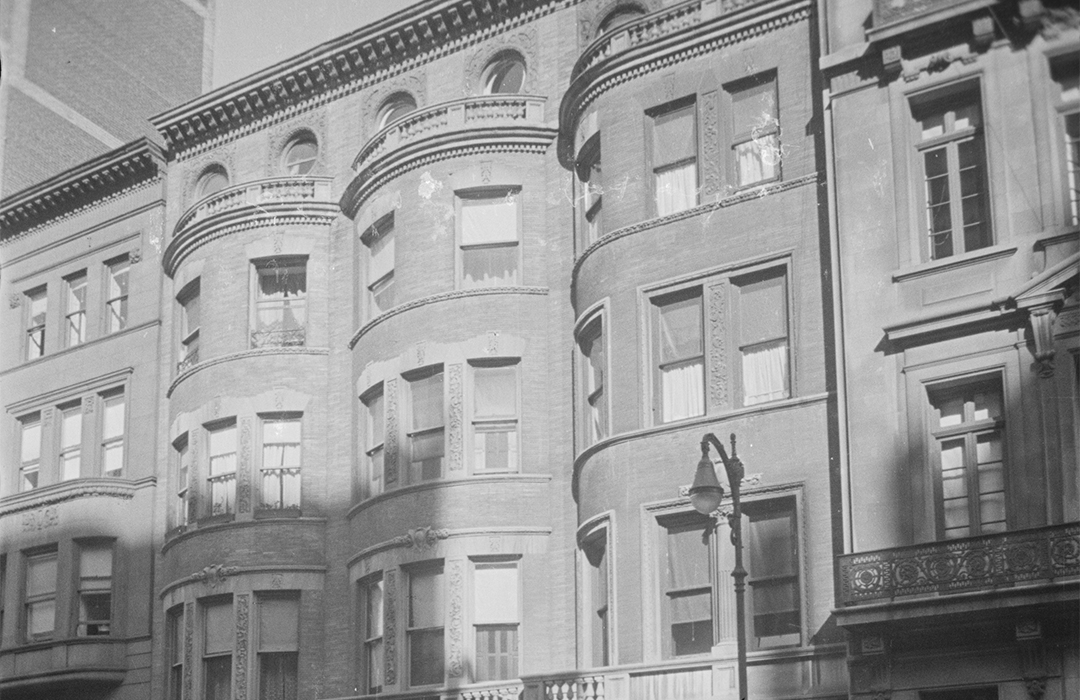
19-21 West 68th Street
by Tom Miller
On April 28, 1894, the Real Estate Record & Builders’ Guide announced that architect George F. Pelham was preparing plans for seven townhouses on West 68th Street for developer Peter Wagner. While four of the homes would be faced in brownstone and have high-stoops, the other three would be “American basement homes” of “buff brick.” The American basement–whereby the houses entered nearly at street level–was becoming increasingly popular. The Guide noted, “All of the houses will be finished in a high-class manner.
The project was completed within the year. Nos. 17 through 21 sat on stone bases, which supported four floor of beige brick. The circular openings of the fifth floors handsomely framed in carved limestone. They trio was shockingly similar to a row of homes completed that same year on West 70th Street, designed by Clarence True.
Real estate operator Beverley Ward and his wife, Caroline, purchased No. 21. It would be conveniently close to his new branch office at No. 344 Columbus Avenue, which he had opened earlier that year. In reporting on his new location, The Record & Guide pointed out that he was “well known among the real estate men of 125th street during the building up of that thoroughfare into the handsome business street it now is” and presumed him “will undertake new business with the same area and courtesy that he has handled the old.”
No. 17 would become the home of Charles A. Baudoine, Jr. and his wife, Annie. The son of the wealthy and famous cabinetmaker, he took over his father’s extensive real estate business following his death in 1895. His and Annie’s romance were fodder for society gossip for years.
In 1894, he married Agnes M. Rutter, daughter of Thomas Rutter, president of the New York Central Railroad. That same year the pair became friendly with writer Casper W. Whitney and his wife, Annie, who lived nearby the newlyweds on West 58th Street. In December of that same year, the Baudouines were divorced and a month later, the Whitneys separated.
His and Annie’s romance were fodder for society gossip for years.
Six months later Charles and his new love were married and sailed off to Europe. Upon their return, they found that Casper Whitney had sued to have his wife’s divorce decree set aside and he filed for his own divorce. Since the original divorce was no longer legal, neither was Charles’ and Annie’s wedding. The couple remarried amid the glare of newspaper and society attention.
They remained in No. 17 until February 1902 when they sold the house to Judge Irving Lehman and his wife, the former Sissie Straus. Lehman was appointed to the Supreme Court in 1908, disappointing Tammany Hall, which had lobbied hard for its own nominee.
No. 19 had been the home of Rosa E. Wormser until September 1903, when she sold it to Henry Silcocks. The well-to-do businessman was a partner in the United States Waste Company, which manufactured and dealt in “wool and cotton waste, lubricants and machine supplies,” according to Steel and Iron magazine.
In the meantime, Otto Loengard had garnered a substantial fortune in, among other ventures, the Comstock Tunnel Company of which he was an officer. The firm provided drainage to the famous Comstock Load mines, where the blue mud had originally hampered miners’ progress.
In February 1899, the Wards sold No. 21 to Otto and Emma Loengard. Emma wasted no time, apparently, in decorating her new home in the latest vogue.
The Loengards remained in No. 21 for over a decade, selling it on April 4, 1900 to William Hawkins Clarke. His $30,000 mortgage–more than $900,000 today–hints at the substantial selling price.
Clarke and his wife, the former Virginia Vilas, had two daughters, Dorothy and Lois, and a son, Percival Vilas. Following the death of Virginia’s father, Henry Chapman Vilas, in 1908, her mother Sophia moved into No. 21 with the family.
The engagement of Dorothy to Columbia graduate Clinton Gilbert Abbott on February 20, 1915 caused a stir in society columns. Following the wedding in St. Stephen’s church in May, a reception was held in the 68th Street house.
Joy turned to grief six months later when Sophia Vilas died in her room on November 19, 1915.
Two years later, in February 1917, Clarke sold No. 21 to broker Joseph L. Lilienthal and his wife, Edna Arnstein Lilienthal. The couple had three children, Joseph, Jr., Philip and Ann. When Henry Silcocks sold No. 19 in 1922, the Lilienthals purchased that property as well, leasing it to Jared Flagg.
The Lilienthal family would remain in No. 21 until Lilienthal’s death at the age of 55 on May 22, 1936; by which time the upscale tone of the neighborhood had eroded. Within two months, Edna had moved out and on July 13, it was announced that she had leased Nos. 19 and 21. The New York Times reported, “The lessee plans to remodel the buildings into one and two-room apartments.”
By now, No. 17 was home to Alfred H. Caspary, principal in the stock brokerage firm A. H. Caspari & Co. and world-renowned philatelist. While the Great Depression prompted owners along the block like Edna Lilienthal to convert their homes to apartments, Alfred and Margaret Caspary were little affected.
Despite the passage of more than half a century, fans still make the pilgrimage to West 68th Street to see the house where he once lived.
The couple’s country estate was in Livingston Manor, New York. While they amassed a notable collection of ceramics, he would be remembered for Alfred’s stamp collection. Some items in his collection were unique–he owned, for instance, the only two 5-cent red Annapolis Postmaster’s provisional stamps known to exist.
Mary died in 1953. Although Alfred remained in No. 17, he was by now nearly bedridden. In 1954, he donated $1 million to erect the Margaret H. Caspary Clinic at the New Hospital for Special Surgery. When he died the following, January at the age of 77, he left an estate estimated at between $10 and $15 million to his friend, George Murnane “for distribution in his discretion.”
Within the year, No. 19 was converted to apartments like its neighbors. No doubt the most celebrated of the tenants within the row was young actor James Dean, who moved into the top floor of No. 19 in 1953.
Dean was still renting the 68th Street apartment when he died on September 30, 1955 in the now-famous California car crash. Despite the passage of more than half a century, fans still make the pilgrimage to West 68th Street to see the house where he once lived.
The homes have undergone some distressing alterations, including gruesome entrance doors. Nevertheless the George Fred Pelham’s 1894 elegant design subsists; a reminder of the time when the block west of Central Park was home to wealthy, prestigious families.
Tom Miller is a social historian and blogger at daytoninmanhattan.blogspot.com



